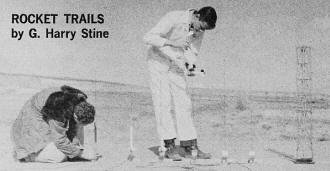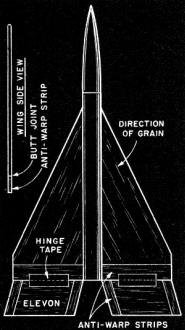Rocket-boosted gliders grew
in popularity in the early 1960s and then seemed to ebb by the end of the decade.
I'm not sure why. Maybe the rocketry purists drove a more timid Boost Glider (B/G)
bunch into the background. I remember getting some pretty nice flight out of my
Estes Falcon glider. This article from the 1963 March/April
edition of American Modeler magazine mentions Vern Estes' efforts to foster the boost glider
craze by modifying what I knew as the Gyroc to perform as
a glider once the engine cartridge was ejected, rather than recover in its original
form by creating a high drag profile via a rapid spin. Rockets, like free flight
model airplanes, need a lot of open space if altitudes of more than a few hundred
feet are planned. Sure, you can estimate the angle for the launch pad tin hopes
of firing upwind enough to allow the rocket to be blown back near the launch location,
but I can tell you from personal experience that just a model airplanes can be unexpectedly
snatched by a passing thermal and carried away to the hinterlands, so too can a
model rocket hanging on a parachute. In fact, since I grew up on the East Coast
near Annapolis, Maryland, where large, open spaces are rare, I always configured
my parachutes (small diameter or larger with hole in the middle) to bring the rocket
back down ASAP. The problem with that is then you don't get to enjoy watching the
rocket float down for very long.Rocket Trails

Chuck Olson and Del Hitch load birds onto rod launchers.
by G. Harry Stine
Boost Gliders (B/G): Winged "Birds"
Five years ago the only model rocket range in U.S. was at Green Mountain
Proving Ground near Denver.
A group of R/C and free-flight fans showed up on one of the NAR model rocket
ranges this Fall. Had read this column and decided to see if it was for real. When
confronted with a boost-glider and explanation of its working, one hardened aeroplane
builder remarked, "Look, I've been building model airplanes for 20 years! These
things can't possibly fly! They've got all the gliding characteristics of a brick!"
Whereupon an undaunted modrocknut slipped an engine in one and sent it aloft for
a 57 second flight while eyes popped like champagne corks.
"You're keepin' it up there by mental telepathy! It can't fly like that!" objected
one of the plane lads. After five more B/G's hit for the blue and did the same,
the airplane builders retired to their drawing boards.
New in Boost Glider (B/G)
Vern Estes modified a standard Space Plane and flew
it to a Senior National Record of 1 :44 at NARAM-4. He takes a regular Space Plane
and screws the elevons down flat. Out comes the standard engine block. Off comes
the nose cone... this is replaced by a hollowed-out round nose cone. New cone is
glued on. Spin tabs on rudders are removed, as well as elevon elastic.

How times have changed! Today modrocknuts ready modern launch rack in White Plains, N. Y. Hundreds of ranges now, plus 30,000 fans.
Modified bird must be flown as follows: empty engine casing with nozzle removed
is taped onto front of loaded engine, and combo is slipped into body so that empty
tube comes up against base of nose cone. This puts weight of an empty engine casing
up front. When engine ejects, it pulls empty casing out with it, jerking weight
out of nose. B/G then flips over on its back and glides like crazy with no elevon
setting at all.
I built one like it, gluing elevons in place and leaving off everything not required.
My modified Space Plane turned in 47 seconds with a 1/2A.8-2 engine. Vern now claims
an unofficial time of 1:57 with a "modified-modified" job.
Many modifications showing up on Centuri "Acro-Bat" B/G, too. Mostly increased
wing area, movement of area aft, anti-warp strips, lighter nose cone. Anti-warp
strips are pieces of sheet balsa butt-joined to wing or elevon edges (as shown in
drawing) with grain running 90-degrees to main wing grain to prevent warp and add
strength. Needed if increased area is used. Have seen modified "Aero-Bats" turn
in 50-plus seconds with half-A engines, too.
R/C gear presently going into a B/G by Marshall P. Wilder of CBS Labs in Connecticut:
Ontarion O-21 receiver and CitizenShip Model SE escapement for rudder-only control
during glide. CG "Venus" tone transmitter being used. Rocket-borne gear weighs in
at a shade over 3 ounces with batteries. Escapement will actuate rudder, not elevons;
rudder and elevons to be locked in zero incidence during powered flight. Expected
to fly when weather clears in March; R/C flights will be preceded by trim hops using
clay to simulate weight of radio gear. At the speeds B/G's are capable of flying,
who wants to risk his gear on the first flight?
New Model Rocket Company
Scientific Amateur Supply Co., P.O.
Box 732, Ogden, Utah, is headed up by my old rocket-shootin' buddy and Thiokol
propellant
chemist John Rahkonen. Outfit has a line of plastic nose cones, tracking aids, electrical
igniters, and two rocket engines. One produces an average thrust of 1.3 pounds for
4 seconds; the other, 2.5 pounds for 6 seconds. Can be had with time delay and ejection
charge.
These advertised specs are being checked by the NAR Testing Committee.

Boost-glider modifications.
Gay Traveler
I have been to gay Paree in the cause of international
model rocketry. The National Aeronautic Associa-tion submitted the NAR's rules to
the Federation Aeronautique Internationale in Paris. Committee on aeromodeling will
consider them for internats rules.
The Iron Curtain countries held their first rocket meet in Krakow, Poland last
summer. Looking forward to the possibility of competing with the Russians in the
scale events and getting a peek at their scale substantiation data! I imagine that
CIA would like to do that too! Remark about this from Del Hitch at NARAM-4: "Russians
will probably show up with scale models of American missiles, giving substantiation
data that American modelers can't even get because it is top secret here!"
Magic Batt?
If you want miniaturization and portability in your
electrical firing systems, get a set of size D sintered-plate nickel-cad batteries,
Many types of nickel-cads are pressed-plate types that will not throw any more cur-rent
than a standard dry cell. But sintered-plate jobs are available from the Gould-National
Corporation, New York City.
These little bombs, expensive as all get-out, are rechargeable, will last forever,
are the same size and weight as standard flashlight cells, will throw a short-circuit
current of 50 amperes with a shorted cell voltage of 1.1 volts! Four of them in
series will fire a nichrome igniter in about a second, and will do it over and over
and over again. When they run down, recharge them again for 16 hours at 400 milliamperes
with something like an HO train power pack.
I have a complete firing system housed in a 3" x 4" x 5" aluminum chassis box,
batteries and all. There is little you can do to harm these sintered-plate powerhouses
- they are sealed and will stand a great deal of abuse. When you are not using them
for firing model rockets, you can always slip them into a flashlight. Or maybe use
them as booster batteries to start your car on cold mornings? Start a car with four
flashlight cells in series? Sure, with sintered-plate N-C's.
Lack of Ranges
Lots of young modrocknuts ask about how to find
a place to fly. In the first place, the problem isn't unique to model rocketeers.
The model airplane boys have the same trouble. I say to all, you don't stand much
chance without adults. You gotta have 'em. They are better at making the necessary
contacts, talking to the right people, agreeing to accept the responsibility for
your little jaunts into the troposphere. There are no pat solutions to the flying
space problem. Each locality has different conditions. Read the reports in this
magazine to learn how some model airplane clubs have licked their flying site difficulties.
As a matter of fact, check all the articles in American Modeler. You'll pick
up lots of tips that can be applied to model rockets. This rocket hobby grew out
of model aviation, there are techniques common to both. I would like to see closer
coordination and more swap-ping of information between the two activiries. It would
be good for both.
Questions/Answers
Ned Hood of Bevery, N. J. wants more data
on the Hans-Scott movie camera rocket. Okay, Ned, you'll get it in future issues.
Also more about the R&D projects at NARAM-4.
Glenn Ford (not the movie actor) of Granada Hills, Calif. queries about Class
E and Class F engines. All Coaster engines are Class F. Some of the new SASCO engines
are Class F, perhaps Class E also when testing shows classification. Class E engines
have 4.01 to 8.0 lb-sec. total impulse; Class Fare 8.01 to 16.0 lb-sec,
Also, Glenn, a 36-inch launch rod made from 1/8" music wire usually won't take
a model weighing more than 6 ounces because (A) the short length of the rod doesn't
allow the model to gain enough air speed before leaving the launcher, and (B) the
slim rod isn't stiff enough for heavy jobs because it can be easily bent. For models
weighing over 6 ounces, I usually use a 5' long, 3/16" steel rod - or a 6-foot,
1/4" diameter steel rod. Some models with high thrust-to-weight ratio can be flown
from 3-foot rods, but it is better not to take chances. If the initial thrust-to-weight
ratio is less than 5, or if the engine is a slow starter that doesn't build thrust
quickly, use a long rod.
Ram Jet
Hottest propulsion news in a long time involves a ram
jet that uses compressed air and produces thrust while standing still. Invented
by Dr. Henri Coanda of France, the unit is simple, has no moving parts, works on
7.5 psi .air, uses mass flow induced by creating a high speed boundary layer. The
Coanda Duct has been used in France for many things-to blow fresh air into mines,
for example. Since no combustion is involved, there is no heat. Operation should
be virtually noiseless.
As I get additional details on this gadget, I will pass them on. Dr. Coanda is
a living legend of aeronautics and fluid dynamics, having flown the first turbo-jet
airplane in 1910 and having designed, among other things, the Bristol F2B "Brisfit"
WW-I fighter. Dr. Coanda is still going strong.
Happy Birthday
Model rocketry and the NAR celebrating their
joint Fifth Anniversary. Born with the Space Age in 1957, our hobby has come a long
way. Perhaps on this occasion the Old Rocketeer may be permitted to ramble on back
a bit. Model rockets flying over the Nebraska plains and the New Mexico deserts
when Orville Carlisle and the O.R. were the only two model rocketeers. Del Hitch
and O.R. riding around in a car trying to find a place to fly, finally letting a
few go in a bulldozed field that is now covered with houses near the Martin "Titan"
ICBM plant in Denver. The search to find somebody to mass-produce model rocket engines
so we wouldn't have to load them our-selves, finally encountering Lawrence Brown
in Missouri (since gone on the long trajectory).
I still have my first model rocket so I took out some of the original engines
the other day to see if they were still good. When run on my static test stand,
these 5-year-old solid propellant model rocket powerplants performed as well as
their companions did right after they were made... which indicates the fantastic
reliability of our power packages.
Posted February 2, 2024
(updated from original
post on 11/17/2012)
|